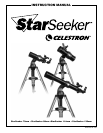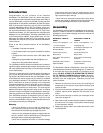
9
Double Stars: Alphabetical listing of the most visually
stunning double, triple and quadruple stars in the sky.
Variable Stars: Select list of the brightest variable stars
with the shortest period of changing magnitude.
Asterisms: A unique list of some of the most recognizable
star patterns in the sky.
5. Info: Displays coordinates and useful information about
objects selected from the StarSeeker database.
6. Tour: Activates the tour mode, which seeks out all the best
objects for a given month and automatically slews the
StarSeeker to those objects.
7. Enter: Pressing Enter allows you to select any of the
StarSeeker functions, accept entered parameters and slew
the telescope to displayed objects.
8. Undo: Undo will take you out of the current menu and
display the previous level of the menu path. Press Undo
repeatedly to get back to a main menu or use it to erase
data entered by mistake.
9. Menu: Displays the many setup and utilities functions such
as tracking rate and user defined objects and many others.
10. Scroll Keys: Used to scroll up and down within any of the
menu lists. A double arrow symbol on the right side of the
LCD indicates that the scroll keys can be used to view
additional information.
11. Rate: Instantly changes the rate of speed of the motors
when the direction buttons are pressed.
12. RS-232 Jack: Allows use with a computer and software
programs for point and click slewing capability.
Hand Control Operation
This section describes the basic hand control procedures
needed to operate the StarSeeker. These procedures are
grouped into three categories: Alignment, Setup and Utilities.
The alignment section deals with the initial telescope align-
ment as well as finding objects in the sky; the setup section
discusses changing parameters such as tracking mode and
tracking rate; finally, the last section reviews all of the utility
functions such as adjusting the telescopes slew limits and
backlash compensation.
Alignment Procedure
In order for the StarSeeker to accurately point to objects in the
sky, it must first be aligned to known positions (stars) in the
sky. With this information, the telescope can create a model of
the sky, which it uses to locate any object with known coordi-
nates. There are many ways to align the StarSeeker with the
sky depending on what infor-
mation the user is able to
provide: SkyAlign uses your
current date, time and city to
create an accurate model of
the sky. Then the user can
simply point the telescope
to any three bright celestial
objects to accurately align
the telescope with the sky.
Auto Two-Star Align will
ask the user to choose and
center the first alignment
star, then the StarSeeker will
automatically select and slew
to a second star for alignment. Two-Star Alignment requires
the user to identify and manually slew the telescope to the two
alignment stars. One-Star Align is the same as Two-Star Align
however only requires you to align to one known star. Although
not as accurate as the other alignment methods, One-Star
Align is the quickest way to find and track bright planets and
objects in Altazimuth mode. Finally, Solar System Align will
display a list of visible daytime objects (planets and the moon)
available to align the telescope. Each alignment method is dis-
cussed in detail below.
1
2
3
4
5
6
7
8
9
10
11
12
Figure 3-2. The StarSeeker hand control
Definition
"Altazimuth" or "Alt-Az"
refers to a type of mounting
that allows a telescope to
move in both altitude (up
and down) and azimuth
(left and right) with respect
to the ground. This is the
simplest form of mounting
in which the telescope is
attached directly to a tripod


















